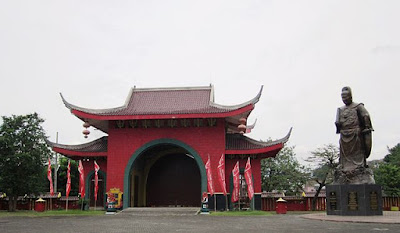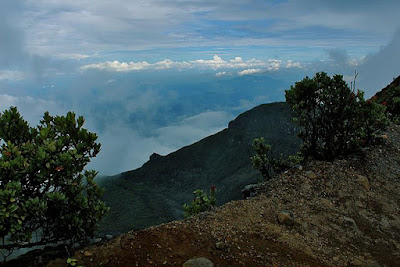THE SAM PO KONG TEMPLE
 |
| Image by 22Kartika - Own work, CC BY-SA 3.0 |
Hundreds of years ago, Admiral Cheng Ho of Ming dynasty sailed to Central Java and set foot in West Semarang in 1416. Later, the Sam Po Kong temple was built at Simongan Hill to commemorate him.
At that time, Admiral Cheng Ho had to stop at Semarang because one of his helmsmen fell sick. Afterwards, he left a traditional healer and some crews to take care of the sick Ong Keng Hong. He could no longer stay with them and should start his journey as soon as possible.
Ong Keng Hong steadily recovered after receiving an intensive medical treatment. After the helmsman regained his health, the traditional healer, crews and he lived together with the locals at Simongan Hill.
As they were the followers of Islam, they spread Islamic religion and explained to people the benefits of becoming a Muslim. Besides, they also told the locals about their leader’s courage and generosity.
What Ong Keng Hong said was positively responded by the locals and they made up their mind to build a symbol of respect in one of the caves. The stone building was then developed into Sam Po Kong temple.
Although it is a Tridharma (Buddhism, Taoism and Confucianism) temple, a lot of people of other religions go on a pilgrimage to Ong Keng Hong’s grave. Besides, there’re tourists going there for historical tour.
The cave of stone building still exists in modern times. It is located under the basement of the temple. Though there’re the staircase and dim light, it can’t be accessed by visitors. There are the iron bars that block the way of the pilgrims. Only Cheng Ho’s statue can be seen in the middle of the room.
The temple was renovated several times. In 1700s, the cave that was used as shelter by Cheng Ho was covered with mud because of landslide.
It is said that the cave in Sam Po Kong temple isn’t the original one. Due to whirlwind, the old cave collapsed in 1704.
There’re Sam Po Kong temple, Earth god temple, Helmsman temple and Anchor temple in this temple complex.
Sam Po Kong cave was monopolized by a landlord of Jewish descendent in the old days. Possibly, his ancestor was Shylock the Great. He usually charged every visitor an amount of money and caused a lot of complaints from the locals. Later, a merchant bought the location and freed the pilgrims from being cruelly charged.
Though it is a Tridharma temple, it doesn’t overwrite the history of Cheng Ho and his crews as the Muslim explorers. The temple is now three and a half hectares in size. During the last renovation in 2005, the relief of Cheng Ho’s journey was added to the wall of the temple. Under the relief, there’re the descriptions written in Indonesian, English and Chinese.
Unlike Cheng Ho’s room that was built in a cave, the Ong Keng Hong building stands on the left side of the main temple.
The Javanese and the people of Chinese descendent respect Ong Keng Hong very much as he was so friendly with the inhabitants. He died in the age of 87 and was buried beside Sam Po Kong cave.
Behind the altar, there’re the words Kyai Djoeroemoedi carved on Ong Keng Hong’s gravestone surrounded by mosquito net.
There is a 2x3 carpet in front of the 1.5 meter grave with the place for putting ritual offerings brought by the pilgrims.
It is usually very crowded on Kliwon Friday night. People of different ethnicities and beliefs come to worship. Perhaps, this is the tradition that has been handed down for centuries.
The Kyai Jangkar room is on the left of Ong Keng Hong building. There’s a 4 meter anchor behind the rectangular altar.
Cheng Ho led 300 large ships to travel around the world. Each ship was at least 130 meters long and 55 meters wide and had 9 masts.
The local believed that the sacred anchor belonged to one of Cheng Ho’s ship. People usually have a special worship to Hoo Ping (homeless spirits), including Cheng Ho’s crews.
The anchor is used for concentration during meditation or worship. There is a hundred year old climbing plant that looks like a chain near the anchor. The locals in olden days said that it was the chain of Cheng Ho’s ship.
Nowadays, the Sam Po Kong temple is one of the popular tourist attractions in Semarang. Each tourist need to pay 25,000 rupiah for the entrance fee.



Comments
Post a Comment